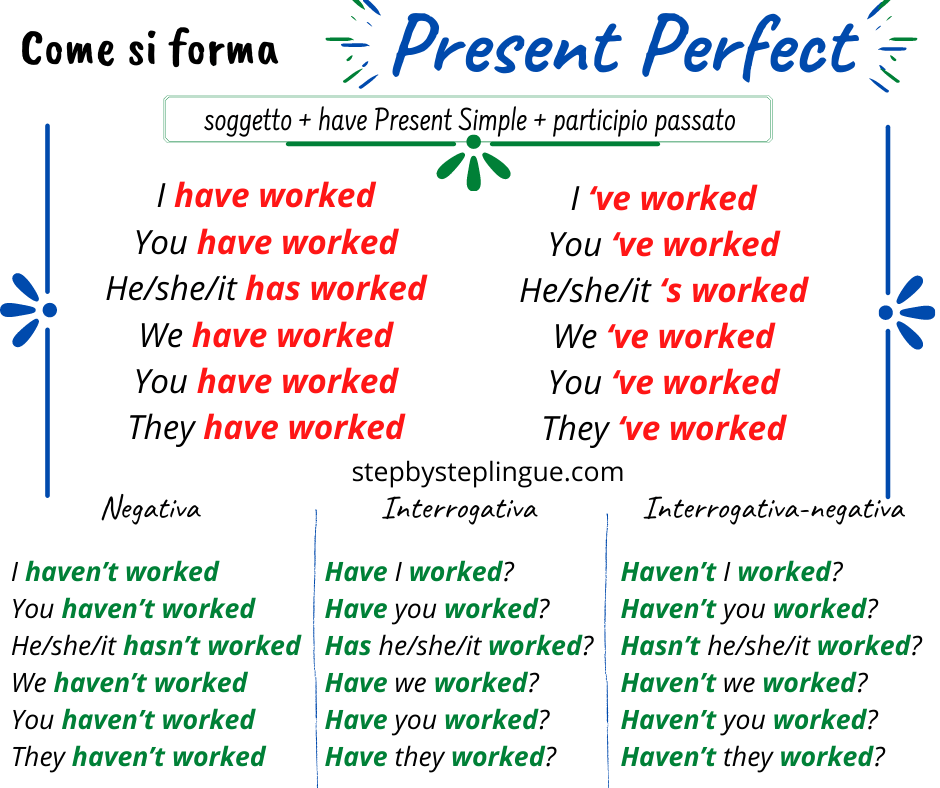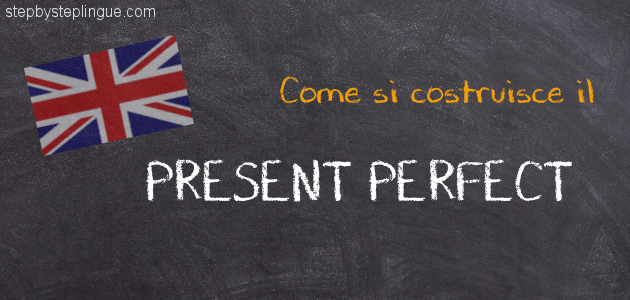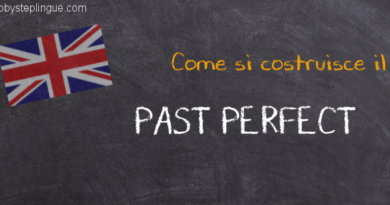Come si forma il Present Perfect
Il Present Perfect è un verbo composto inglese costituito da due elementi: il verbo to have e il participio passato. Questo vale sia per la forma affermativa, che negativa e interrogativa.
Ripassa questi Step:
Il verbo to have al Simple Present
Come si forma il Past Simple
Tabella: verbi irregolari in inglese
Argomenti di questo Step
Come si costruisce il Present Perfect?
Il Present Perfect viene definito “verbo composto” in quanto si costruisce unendo due elementi.
La regola per costruire il Present Perfect, infatti, è:
soggetto + to have al Simple Present + participio passato
Osserva:
| I | have | worked |
| You | have | worked |
| He/she/it | has | worked |
| We | have | worked |
| You | have | worked |
| They | have | worked |
Esiste anche la forma contratta nella forma affermativa del Present Perfect e viene usata specialmente in linguaggio informale.
Si costruisce contraendo have con il soggetto, in questo modo:
| I ‘ve worked |
| You ‘ve worked |
| He/she/it ‘s worked |
| We ‘ve worked |
| You ‘ve worked |
| They ‘ve worked |
In generale possiamo dire che traduciamo il Present Perfect in italiano con il passato prossimo.
Attenzione al contrario! Non è detto che un passato prossimo italiano corrisponda sicuramente al Present Perfect! Ma questo lo vediamo nel dettaglio nello Step: Quando si usa il Present Perfect?
Attenzione a non confondere la ‘s di to have con la ‘s del genitivo sassone!
Ripassa questo Step: Genitivo sassone o to have?
Vediamo qualche frase di esempio con il Present Perfect:
I have already got up – Mi sono appena alzato
He has received your email – Ha ricevuto la tua email
Lately I have bought new shoes – Di recente ho comprato delle scarpe nuove.
I have seen Paul this morning – Ho visto Paul questa mattina.
Come si forma il participio passato in inglese
Come abbiamo visto nella regola qui sopra, per costruire il Present Perfect abbiamo bisogno anche del participio passato.
Per formare il participio passato dobbiamo distinguere tra i verbi regolari e i verbi irregolari.
Verbi regolari
Nei verbi regolari, la regola è la stessa identica che seguiamo per formare il Past Simple:
forma base del verbo + -ed
Le particolarità ortografiche nell’aggiunta di -ed sono le stesse che abbiamo visto nel Past Simple.
Esempi con le particolarità ortografiche:
I have travelled
I have studied
I have stopped
I have preferred
Verbi irregolari
Per i verbi irregolari dobbiamo fare riferimento alla tabella dei verbi irregolari inglesi.
Quelli che ci serviranno saranno i verbi elencati nella terza colonna.
Esempi:
I have begun (begin – began – begun)
I have been (be – was/were – been)
I have forgiven (forgive – forgave – forgiven)
I have heard (hear – heard – heard)
La forma negativa
Per creare la forma negativa del Present Perfect dobbiamo aggiungere la negazione not appena dopo il verbo have:
soggetto + have Simple Present + not + participio passato
La forma contratta, invece, si costruisce contraendo have/has con not.
Esattamente come abbiamo visto nella forma affermativa, la forma estesa si usa in modo formale, quella contratta è più informale.
| I have not worked | I haven’t worked |
| You have not worked | You haven’t worked |
| He/she/it has not worked | He/she/it hasn’t worked |
| We have not worked | We haven’t worked |
| You have not worked | You haven’t worked |
| They have not worked | They haven’t worked |
Qualche frase di esempio con il Present Perfect nella forma negativa:
He hasn’t received your email – Non ha ricevuto la tua email
Lately I haven’t bought new shoes – Di recente non ho comprato delle scarpe nuove.
I haven’t seen Paul this morning – Non ho visto Paul questa mattina.
La forma interrogativa
Per quanto riguarda la forma interrogativa del Present Perfect si costruisce invertendo il soggetto e il verbo have:
have al Simple Present + soggetto + participio passato + ?
Non esiste la forma contratta.
| Have I worked? |
| Have you worked? |
| Has he/she/it worked? |
| Have we worked? |
| Have you worked? |
| Have they worked? |
Qualche frase di esempio con il Present Perfect nella forma interrogativa:
Has he received your email? – Ha ricevuto la tua email?
Have I bought new shoes lately? – Di recente ho comprato delle scarpe nuove?
Have you seen Paul this morning? – Hai visto Paul questa mattina?
La forma interrogativa-negativa
Per la forma interrogativa-negativa dobbiamo invertire soggetto e verbo e aggiungere la negazione not:
have al Simple Present + not + soggetto + participio passato + ?
Esiste solo la forma contratta, che si forma contraendo il verbo have con la negazione not.
| Haven’t I worked? |
| Haven’t you worked? |
| Hasn’t he/she/it worked? |
| Haven’t we worked? |
| Haven’t you worked? |
| Haven’t they worked? |
Qualche frase di esempio con il Present Perfect nella forma interrogativa-negativa:
Hasn’t he received your email? – Non ha ricevuto la tua email?
Haven’t I bought new shoes lately? – Di recente non ho comprato delle scarpe nuove?
Haven’t you seen Paul this morning? – Non hai visto Paul questa mattina?
Risposte brevi al Present Perfect
Che cos’è una risposta breve?
Mettiamo che ci venga posta una domanda che implica semplicemente un sì o un no come risposta (es. Tu lo hai visto? Sì): questa viene definita risposta breve. In inglese, nelle risposte brevi è buona norma non rispondere semplicemente con sì o no, ma aggiungere anche il verbo have.
Risposte brevi affermative
Have you seen Paul this morning? – Hai visto Paul questa mattina?
Yes, I have – Sì, l’ho visto.
Quando si danno delle risposte brevi affermative, soggetto e verbo have sono sempre espressi nella forma estesa. Una risposta del tipo yes, I’ve non esiste!
Risposte brevi negative
Have you seen Paul this morning? – Hai visto Paul questa mattina?
Yes, I haven’t – No, non l’ho visto.
Quando si danno delle risposte brevi negative è preferibile, invece, utilizzare la forma contratta haven’t.
Passa allo Step successivo:
Quando si usa il Present Perfect?
Present Perfect o Past Simple?
Come si forma il Present Perfect Continuous?
Quando si usa il Present Perfect Continuous?
Present Perfect o Present Perfect Continuous?
Come si forma il Past Perfect?
There is e there are al Present Perfect
Torna agli Step precedenti:
Il Past Simple dei verbi irregolari in inglese
Il verbo to be al Past Simple
Il verbo to have al Past Simple
Tutti gli Step di grammatica inglese:
Indice argomenti di grammatica

Test yourself!
I libri che ti consiglio in questo Step
👩🏫 Grammar reference
👩🏫 Oxford practice grammar – Elementary Book
👩🏫 Essential Grammar in Use
👩🏫 English Vocabulary in use – Elementary Book
👩🏫 Dizionario Inglese-Italiano e Italiano-Inglese
🐕 The Hundred and One Dalmatians
Scopri i libri migliori per imparare l’Inglese:
Libreria di Inglese





